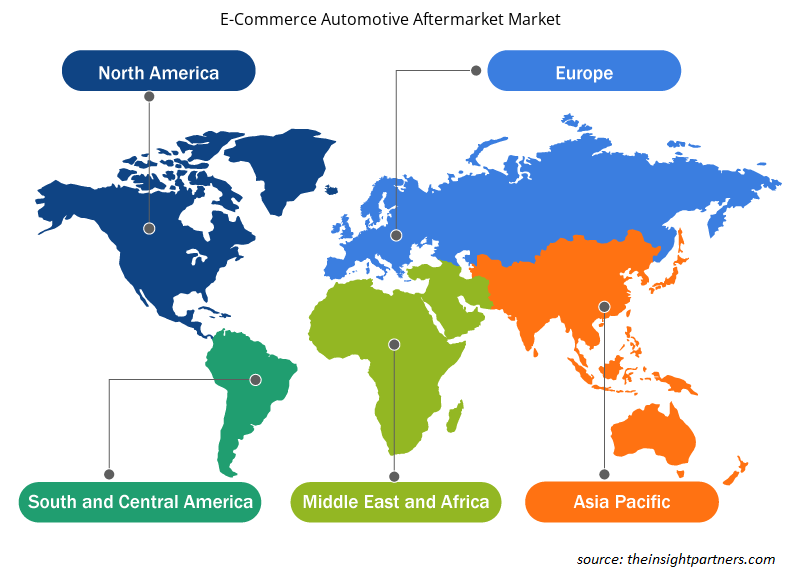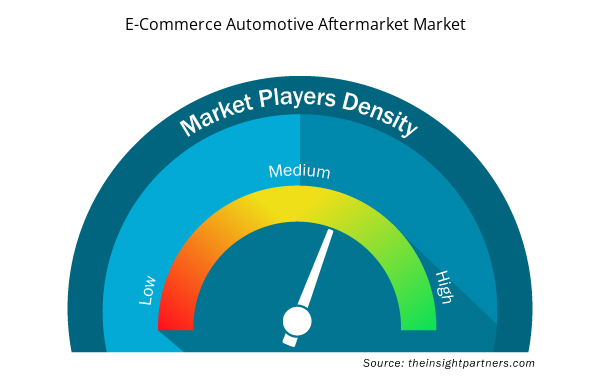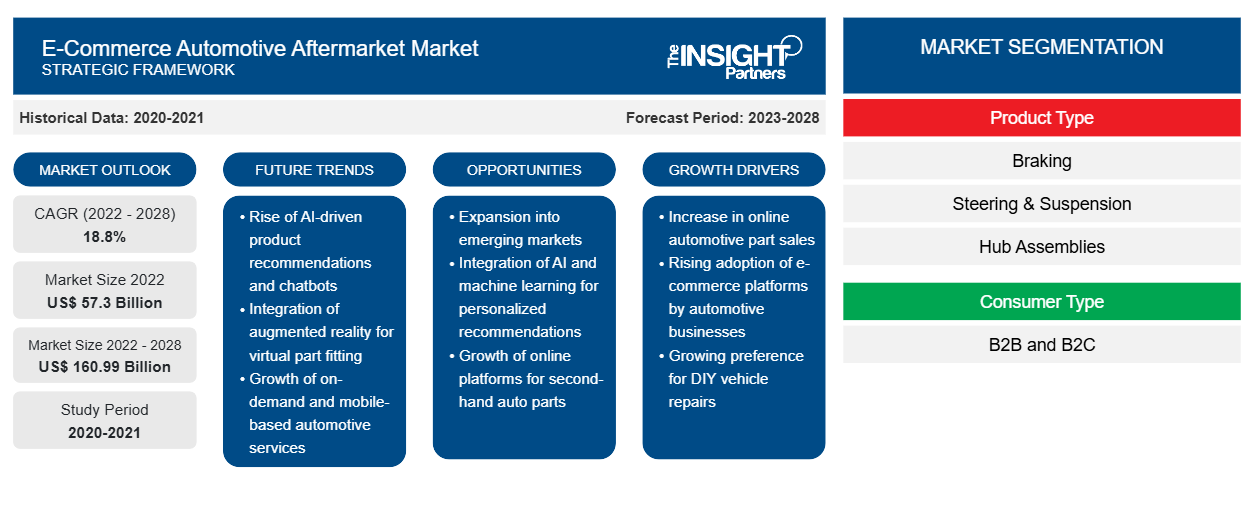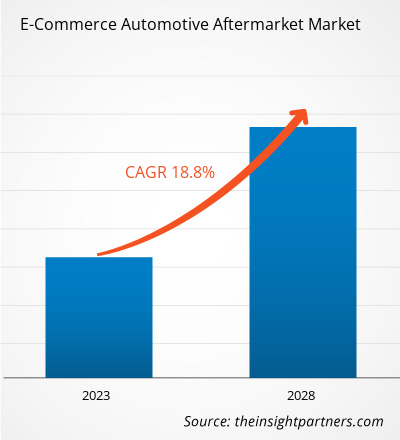Der E-Commerce-Markt für den Kfz-Ersatzteilmarkt soll von 57.301,1 Millionen US-Dollar im Jahr 2022 auf 160.985,4 Millionen US-Dollar im Jahr 2028 wachsen. Von 2022 bis 2028 wird mit einer durchschnittlichen jährlichen Wachstumsrate von 18,8 % gerechnet.
Nordamerika verfügt aufgrund der kontinuierlichen Produktion von Nutzfahrzeugen über eine entwickelte Automobilindustrie. Laut dem Bericht 2021 der Organisation Internationale des Constructeurs d'Automobiles ( OICA ) produzierten die USA im Jahr 2021 7.604.154 Nutzfahrzeuge, im Jahr 2020 6.895.604 und im Jahr 2019 8.367.239. Ebenso produzierte Kanada laut dem OICA- Bericht 2021 im Jahr 2021 826.767 Nutzfahrzeuge, im Jahr 2020 1.048.942 und im Jahr 2019 1.455.215 . Mexiko produzierte laut demselben Bericht im Jahr 2021 insgesamt 2.437.411 Nutzfahrzeuge, im Jahr 2020 2.209.121 und im Jahr 2019 2.604.080. Laut OICA- Statistiken sind die USA, Kanada und Mexiko weltweit führend im Segment der Nutzfahrzeugproduktion. Somit unterstützt die kontinuierliche Produktion von Nutzfahrzeugen in der gesamten Region das Wachstum des E-Commerce-Automobil-Ersatzteilmarktes in Nordamerika.
Auswirkungen der COVID-19-Pandemie auf den E-Commerce-Automobil-Ersatzteilmarkt
In Nordamerika war in den USA, Kanada und Mexiko ein deutlicher Anstieg der Zahl der COVID-19-Fälle zu verzeichnen. Viele Produktionsstätten wurden geschlossen, Kommunen arbeiteten nur noch verlangsamt und die Automobil- und Halbleiterindustrie wurde 2020 nach Ausbruch der COVID-19-Pandemie eingestellt. In der Region hatte die Unterbrechung der Wertschöpfungskette durch die Schließung verschiedener Produktionsstätten und Lager in den USA und Kanada aufgrund der COVID-19-Pandemie unmittelbare Auswirkungen auf die kurzfristige Nachfrage, die logistische Infrastruktur und die Produktbestände. Die Automobilindustrie wuchs jedoch weiter, da Online-Kanäle einzigartige Dienstleistungen in Bezug auf Wartung, Reparatur und Austausch boten. Vor Ausbruch der COVID-19-Pandemie expandierte der E-Commerce rasant. Die Pandemie erhöhte jedoch die Zahl der US-Verbraucher, die Online-Plattformen nutzten, was sie dazu ermutigte, mehr Geld auszugeben. Diese Aktivitäten führten zu einem großen Umsatzanteil aufgrund der Durchdringung eines gut organisierten E-Commerce-Ökosystems, das es Automobilzulieferern ermöglicht, E-Commerce-spezifische Aftermarket-Verkäufe zu tätigen. Im April 2021 stiegen die Verkäufe von Autokomponenten, -teilen und -zubehör im E-Commerce-Kfz-Ersatzteilmarkt in den USA und Kanada im Vergleich zum Jahr 2020 um über 60 %.
Passen Sie diesen Bericht Ihren Anforderungen an
Sie erhalten kostenlos individuelle Anpassungen an jedem Bericht, einschließlich Teilen dieses Berichts oder einer Analyse auf Länderebene, eines Excel-Datenpakets sowie tolle Angebote und Rabatte für Start-ups und Universitäten.
- Holen Sie sich die wichtigsten Markttrends aus diesem Bericht.Dieses KOSTENLOSE Beispiel umfasst eine Datenanalyse von Markttrends bis hin zu Schätzungen und Prognosen.
E-Commerce-Markteinblicke in den Kfz-Ersatzteilmarkt
Anstieg der DIY- und DIFM- Konsumenten
Amazon und eBay liefern an vielen Standorten Autoersatzteile noch am selben Tag. Sie unterhalten Geschäftsbeziehungen zu einigen großen Teileherstellern, wie Robert Bosch GmbH , Denso Corp., Magna International Inc., Continental AG und ZF Friedrichshafen AG, die Installationsdienste anbieten. Traditionelle Autoteilelieferanten wissen, dass Kunden, die Autoersatzteile zum Selbermachen kaufen, das erste Segment sind, das von traditionellen Autoteilelieferanten auf digitale E-Commerce-Websites umsteigt. Daher ist die Aufrechterhaltung einer konsistenten Geschäftsbeziehung mit gewerblichen Händlern und Technikern eine einzigartige Strategie, um wettbewerbsfähig zu bleiben. Zu den Standardfunktionen der neuesten Autos gehören Sensoren zur Erkennung von Spurwechseln, 360°-Kameras und Technologie, die fachkundige Unterstützung erfordert.
Im Do-it-for-me-Trend ( DIFM ) werden sich Verbraucher, die moderne Autos besitzen, voraussichtlich auf Autoreparaturbetriebe und Mechaniker verlassen. Advance Auto Parts beispielsweise nutzt E-Commerce, um diese Marktgruppen gezielt anzusprechen, indem es ihnen Funktionen der Fahrerassistenztechnologie bietet. Der E-Commerce-Markt für Kfz-Ersatzteile muss weiterhin digitale B2C- (Business-to-Consumer) und B2B- (Business-to-Business) Marktplätze und die wachsenden Lieferketten, die diese Marktplätze unterstützen, nutzen, da die Konkurrenz weiterhin diesen lukrativen E-Commerce-Markt für Kfz-Ersatzteile verfolgt. Infolgedessen wird erwartet, dass die steigende Zahl der Kunden, die den Online-Kauf von Kfz-Komponenten im E-Commerce-Automobilsektor nutzen, neue Möglichkeiten im E-Commerce-Markt für Kfz-Ersatzteile schaffen wird.
Produkttypbasierte Markteinblicke
Basierend auf dem Produkttyp ist der E-Commerce-Markt für Kfz-Ersatzteile in Bremsen (Bremsbeläge, Hydraulik und Hardware sowie Rotor und Trommel), Lenkung und Aufhängung (Kugelgelenke, Spurstangen, Pendelstangen, Lager/Dichtungen und andere) sowie Radnabenbaugruppen, Kreuzgelenke, Dichtungen, Filter, Zündkerzen und andere unterteilt. Im Jahr 2021 führte das Segment „Sonstige“ den E-Commerce-Markt für Kfz-Ersatzteile an und hatte den größten Marktanteil.
Markteinblicke basierend auf Verbrauchertypen
Basierend auf dem Verbrauchertyp ist der E-Commerce-Markt für Kfz-Ersatzteile in B2B und B2C unterteilt. Im Jahr 2021 führte das B2C-Segment den E-Commerce-Markt für Kfz-Ersatzteile an und hatte einen größeren Marktanteil.
Marktteilnehmer verfolgen Strategien wie Fusionen, Übernahmen und Marktinitiativen, um ihre Positionen im E-Commerce-Markt für Kfz-Ersatzteile zu behaupten. Nachfolgend sind einige Entwicklungen der wichtigsten Akteure aufgeführt:
- Im März 2022 gewann DENSO Aftermarket, die Aftermarket-Tochter von DENSO, einem führenden Hersteller von Erstausrüsterkomponenten (OE), den begehrten Preis „Supplier of the Year 2021“, der von GroupAuto International, einer führenden globalen Einkaufsorganisation, verliehen wird.
- Im September 2020 schloss die LKQ Corporation den zuvor angekündigten Verkauf ihrer Beteiligungen an zwei tschechischen Autoteilegroßhändlern an die Swiss Automotive Group AG ab. Die Bedingungen der Transaktion wurden nicht bekannt gegeben.
Umfang des E-Commerce Automotive Aftermarket-Berichts
Regionale Einblicke in den E-Commerce-Automobil-Ersatzteilmarkt
Die regionalen Trends und Faktoren, die den E-Commerce-Automobil-Ersatzteilmarkt während des gesamten Prognosezeitraums beeinflussen, wurden von den Analysten von Insight Partners ausführlich erläutert. In diesem Abschnitt werden auch die Marktsegmente und die Geografie des E-Commerce-Automobil-Ersatzteilmarkts in Nordamerika, Europa, im asiatisch-pazifischen Raum, im Nahen Osten und Afrika sowie in Süd- und Mittelamerika erörtert.

- Erhalten Sie regionale Daten zum E-Commerce-Automobil-Ersatzteilmarkt
Umfang des E-Commerce-Marktberichts zum Kfz-Ersatzteilmarkt
| Berichtsattribut | Details |
|---|---|
| Marktgröße im Jahr 2022 | 57,3 Milliarden US-Dollar |
| Marktgröße bis 2028 | 160,99 Milliarden US-Dollar |
| Globale CAGR (2022 - 2028) | 18,8 % |
| Historische Daten | 2020-2021 |
| Prognosezeitraum | 2023–2028 |
| Abgedeckte Segmente | Nach Produkttyp
|
| Abgedeckte Regionen und Länder | Nordamerika
|
| Marktführer und wichtige Unternehmensprofile |
|
Marktteilnehmerdichte: Der Einfluss auf die Geschäftsdynamik
Der E-Commerce-Markt für Kfz-Ersatzteile wächst rasant. Dies wird durch die steigende Nachfrage der Endnutzer aufgrund von Faktoren wie sich entwickelnden Verbraucherpräferenzen, technologischen Fortschritten und einem größeren Bewusstsein für die Vorteile des Produkts vorangetrieben. Mit der steigenden Nachfrage erweitern Unternehmen ihr Angebot, entwickeln Innovationen, um die Bedürfnisse der Verbraucher zu erfüllen, und nutzen neue Trends, was das Marktwachstum weiter ankurbelt.
Die Marktteilnehmerdichte bezieht sich auf die Verteilung der Firmen oder Unternehmen, die in einem bestimmten Markt oder einer bestimmten Branche tätig sind. Sie gibt an, wie viele Wettbewerber (Marktteilnehmer) in einem bestimmten Marktraum im Verhältnis zu seiner Größe oder seinem gesamten Marktwert präsent sind.
Die wichtigsten Unternehmen, die auf dem E-Commerce-Markt für Kfz-Ersatzteile tätig sind, sind:
- Alibaba Group Holding Limited
- Amazon.com, Inc.
- AutoZone, Inc.
- Shopee365
- CATI SpA
Haftungsausschluss : Die oben aufgeführten Unternehmen sind nicht in einer bestimmten Reihenfolge aufgeführt.

- Überblick über die wichtigsten Akteure im E-Commerce Automotive Aftermarket-Markt
Firmenprofile
Alibaba Group Holding Limited; Amazon.com, Inc.; AutoZone, Inc.; Shopee365; CATI SpA; eBay Inc.; LKQ Corporation; The Pep Boys; CarParts.com, Inc.; und Denso Corporation sind wichtige führende Marktteilnehmer.
- Historische Analyse (2 Jahre), Basisjahr, Prognose (7 Jahre) mit CAGR
- PEST- und SWOT-Analyse
- Marktgröße Wert/Volumen – Global, Regional, Land
- Branche und Wettbewerbsumfeld
- Excel-Datensatz


- Fixed-Base Operator Market
- Flexible Garden Hoses Market
- Tortilla Market
- Hydrocephalus Shunts Market
- Influenza Vaccines Market
- 3D Mapping and Modelling Market
- Semiconductor Metrology and Inspection Market
- Long Read Sequencing Market
- Intradermal Injection Market
- Lyophilization Services for Biopharmaceuticals Market

Report Coverage
Revenue forecast, Company Analysis, Industry landscape, Growth factors, and Trends

Segment Covered
This text is related
to segments covered.

Regional Scope
North America, Europe, Asia Pacific, Middle East & Africa, South & Central America

Country Scope
This text is related
to country scope.
Häufig gestellte Fragen
Rising number of e-commerce providers and increased replacement rates boost B2C industry are driving the growth of the e-commerce automotive aftermarket market.
Increasing customer awareness for automotive aftermarket is presenting significant potential for the future growth of the e-commerce automotive aftermarket market players.
APAC is the fastest growing region in the global e-commerce automotive aftermarket market.
Based on product type, the e-commerce automotive aftermarket market is segmented into braking, steering and suspension, hub assemblies, universal joints, gaskets, filters, spark plug, and others. In 2021, the others segment led the e-commerce automotive aftermarket market, accounting for the largest share in the market.
The incremental growth of the e-commerce automotive aftermarket market during the forecast period of 2022-2028 is US$ 103,684.37 million.
The major five companies in the e-commerce automotive aftermarket market include Alibaba Group Holding Limited; Amazon.com, Inc.; AutoZone, Inc.; LKQ Corporation; and CarParts.com, Inc.
Trends and growth analysis reports related to Automotive and Transportation : READ MORE..
The List of Companies - E-Commerce Automotive Aftermarket Market
- Alibaba Group Holding Limited
- Amazon.com, Inc.
- AutoZone, Inc.
- Shopee365
- CATI S.p.A.
- eBay Inc.
- LKQ Corporation
- The Pep Boys
- CarParts.com, Inc
- Denso Corporation
The Insight Partners performs research in 4 major stages: Data Collection & Secondary Research, Primary Research, Data Analysis and Data Triangulation & Final Review.
- Data Collection and Secondary Research:
As a market research and consulting firm operating from a decade, we have published and advised several client across the globe. First step for any study will start with an assessment of currently available data and insights from existing reports. Further, historical and current market information is collected from Investor Presentations, Annual Reports, SEC Filings, etc., and other information related to company’s performance and market positioning are gathered from Paid Databases (Factiva, Hoovers, and Reuters) and various other publications available in public domain.
Several associations trade associates, technical forums, institutes, societies and organization are accessed to gain technical as well as market related insights through their publications such as research papers, blogs and press releases related to the studies are referred to get cues about the market. Further, white papers, journals, magazines, and other news articles published in last 3 years are scrutinized and analyzed to understand the current market trends.
- Primary Research:
The primarily interview analysis comprise of data obtained from industry participants interview and answers to survey questions gathered by in-house primary team.
For primary research, interviews are conducted with industry experts/CEOs/Marketing Managers/VPs/Subject Matter Experts from both demand and supply side to get a 360-degree view of the market. The primary team conducts several interviews based on the complexity of the markets to understand the various market trends and dynamics which makes research more credible and precise.
A typical research interview fulfils the following functions:
- Provides first-hand information on the market size, market trends, growth trends, competitive landscape, and outlook
- Validates and strengthens in-house secondary research findings
- Develops the analysis team’s expertise and market understanding
Primary research involves email interactions and telephone interviews for each market, category, segment, and sub-segment across geographies. The participants who typically take part in such a process include, but are not limited to:
- Industry participants: VPs, business development managers, market intelligence managers and national sales managers
- Outside experts: Valuation experts, research analysts and key opinion leaders specializing in the electronics and semiconductor industry.
Below is the breakup of our primary respondents by company, designation, and region:

Once we receive the confirmation from primary research sources or primary respondents, we finalize the base year market estimation and forecast the data as per the macroeconomic and microeconomic factors assessed during data collection.
- Data Analysis:
Once data is validated through both secondary as well as primary respondents, we finalize the market estimations by hypothesis formulation and factor analysis at regional and country level.
- Macro-Economic Factor Analysis:
We analyse macroeconomic indicators such the gross domestic product (GDP), increase in the demand for goods and services across industries, technological advancement, regional economic growth, governmental policies, the influence of COVID-19, PEST analysis, and other aspects. This analysis aids in setting benchmarks for various nations/regions and approximating market splits. Additionally, the general trend of the aforementioned components aid in determining the market's development possibilities.
- Country Level Data:
Various factors that are especially aligned to the country are taken into account to determine the market size for a certain area and country, including the presence of vendors, such as headquarters and offices, the country's GDP, demand patterns, and industry growth. To comprehend the market dynamics for the nation, a number of growth variables, inhibitors, application areas, and current market trends are researched. The aforementioned elements aid in determining the country's overall market's growth potential.
- Company Profile:
The “Table of Contents” is formulated by listing and analyzing more than 25 - 30 companies operating in the market ecosystem across geographies. However, we profile only 10 companies as a standard practice in our syndicate reports. These 10 companies comprise leading, emerging, and regional players. Nonetheless, our analysis is not restricted to the 10 listed companies, we also analyze other companies present in the market to develop a holistic view and understand the prevailing trends. The “Company Profiles” section in the report covers key facts, business description, products & services, financial information, SWOT analysis, and key developments. The financial information presented is extracted from the annual reports and official documents of the publicly listed companies. Upon collecting the information for the sections of respective companies, we verify them via various primary sources and then compile the data in respective company profiles. The company level information helps us in deriving the base number as well as in forecasting the market size.
- Developing Base Number:
Aggregation of sales statistics (2020-2022) and macro-economic factor, and other secondary and primary research insights are utilized to arrive at base number and related market shares for 2022. The data gaps are identified in this step and relevant market data is analyzed, collected from paid primary interviews or databases. On finalizing the base year market size, forecasts are developed on the basis of macro-economic, industry and market growth factors and company level analysis.
- Data Triangulation and Final Review:
The market findings and base year market size calculations are validated from supply as well as demand side. Demand side validations are based on macro-economic factor analysis and benchmarks for respective regions and countries. In case of supply side validations, revenues of major companies are estimated (in case not available) based on industry benchmark, approximate number of employees, product portfolio, and primary interviews revenues are gathered. Further revenue from target product/service segment is assessed to avoid overshooting of market statistics. In case of heavy deviations between supply and demand side values, all thes steps are repeated to achieve synchronization.
We follow an iterative model, wherein we share our research findings with Subject Matter Experts (SME’s) and Key Opinion Leaders (KOLs) until consensus view of the market is not formulated – this model negates any drastic deviation in the opinions of experts. Only validated and universally acceptable research findings are quoted in our reports.
We have important check points that we use to validate our research findings – which we call – data triangulation, where we validate the information, we generate from secondary sources with primary interviews and then we re-validate with our internal data bases and Subject matter experts. This comprehensive model enables us to deliver high quality, reliable data in shortest possible time.


 Holen Sie sich ein kostenloses Muster für diesen Bericht
Holen Sie sich ein kostenloses Muster für diesen Bericht